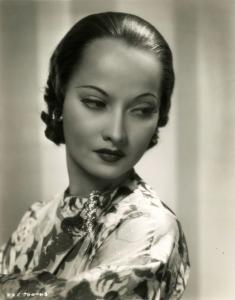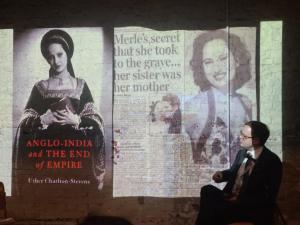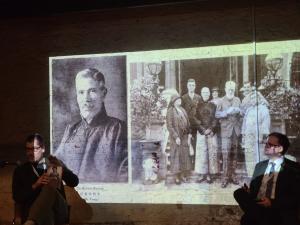
Before Michelle Yeoh's Groundbreaking Oscar Win, Stars like Merle Oberon and Vivien Leigh Had to Hide their Asian Roots.

Anglo-Indian Film Star Merle Oberon was actually born in Bombay in 1911 as Estelle Merle O’Brien Thompson; the first Asian to be nominated for Best Actress for 'The Dark Angel' (1935), Oberon's career as a romantic lead was only possible because she passed as European
Merle Oberon in 'The Dark Angel' (1935) was the first Asian nominated; Vivien Leigh in ‘Gone with the Wind’ (1939) was the first person of Asian descent to win.
Oberon was the first Asian to be nominated for Best Actress for 'The Dark Angel' (1935) – unsurprisingly, few in the press initially picked this up. To secure her career as a romantic lead alongside Douglas Fairbanks, Laurence Olivier and Leslie Howard, Oberon had been willing to conceal her Anglo-Indian roots and Bombay birth. To accomplish this she was willing to change her name and accept a fantasy biography, concocted by her director and future husband, Alexander Korda’s artful publicist, John Myers, who made Oberon learn by heart a series of false facts deftly crafted from half-truths and fragments from her real-life story. Accidental birth in far-off Tasmania to deceased parents and an upbringing with aristocratic godparents living in India supported the pretense of her impeccably British origins. Nonetheless, contemporaries described Oberon as “exotic” and even 1985 biographers Charles Higham and Roy Moseley referred to her “mysterious slanting eyes”. Oberon was also several shades less pale than Italian-American Mia Sara, chosen to depict her passing as white in the 1987 televised adaptation of ‘Queenie’ (1985), a thinly fictionalised account by nephew-in-law Michael Korda. Oberon used toxic makeup to lighten and bleach her skin, and undoubtedly benefited from being filmed mostly in black and white.
Also born in India – in Darjeeling – and also of ‘mixed-race’, Vivien Leigh benefitted from an unquestionably white complexion and a Convent school education in Britain, to provide the markers that would more firmly cement her status as British. Leigh’s British father was from a higher class status within colonial British society than Oberon’s, but this also meant that he was forced to resign his memberships in the prestigious Bengal and Saturday Clubs after marrying her Armenian mother, Gertrude Mary Frances Yackjee. With some members of her extended family alleged to have possessed darker skin tones, Leigh’s famous cousin Xan Fielding, suspected the family of also possessing Parsi or Bengali ancestry. Leigh’s maternal grandfather came from the long-settled Indian Armenian community rather than Armenia itself, although, atypically he was Catholic. This had contributed to his choice of a young Catholic bride from a hill station orphanage where it was common for children of all skin complexions to be mixed-race. Leigh’s Armenian ancestry is now widely acknowledged, but her family has maintained her own assertions that her maternal grandmother was straightforwardly Irish rather than mixed-race, Eurasian or Anglo-Indian. Whatever the precise truth about her mixed and colourful ancestry, Leigh merits recognition as the first person of Asian descent to win an Academy Award—for Best Actress in ‘Gone with the Wind’ (1939).
This complex history has recently been unearthed in ‘Anglo-India and the End of Empire’ (Hurst Publishers, UK, Oxford University Press, USA, 2022), and was the subject of a recent exchange between bestselling China historian Paul French and the book’s author, Uther Charlton-Stevens, at the Hong Kong International Literary Festival:
French: “Was it something that was known? I mean, did Olivier and everyone else know about Merle Oberon’s background, and Vivien Leigh’s background?”
Charlton-Stevens: “I believe that this was a sort of thinly disguised pretense on behalf of the… Hollywood class, but it had to be the case… because there were things like the Hays Code and… you weren’t allowed interracial kissing – even the British censors followed the American model, so that British films would be shown in the U.S. as well. So they didn’t want to show obvious interracial kissing, and they preferred to have somebody doing ‘yellow-face’ makeup, and have a white actress in order to play an interracial romantic scene in various films.”
French: “This is the Anna May Wong must die theory of Hollywood at the time… What you talk about in your book, which is fascinating, is Merle Oberon had her mum with her all the time, right? Who was a little Indian lady in a sari who… followed her around through Hollywood, London, and everywhere where she was. So the people who were close to the family must have [known]. It must have been fairly obvious – or did she hide it?
Charlton-Stevens: “Well, she presented her to people who were not close friends as if she was her nanny, or her aiyah, or her maid… and she got her to wear a frilly apron and she would speak what was then called Hindustani, as if she was a servant. So that is all very uncomfortable, but Merle had a portrait painted of her where… they also I think lightened the skin, which she kept hung in her Hollywood home for her whole life, so she was deeply, deeply attached to her mother… Something which came out in more recent times, in a documentary by [Marée] Delofski – The Trouble with Merle [2002] – was that, and this has been reported recently in an article in the Guardian, was that Merle’s mother wasn’t actually her birth-mother… biologically, the woman she knew as her mother was actually her grandmother, because what had happened was that a romantic partner of her supposed mother had abused the daughter, who was thought to be her sister, but actually was her biological mother.”
Uther Charlton-Stevens
Fellow of the Royal Asiatic Society
+852 5498 1572
uther@charltonstevens.com
Visit us on social media:
Facebook
Twitter
LinkedIn
Instagram
YouTube
Other
Merle Oberon pretended to be Tasmanian but cut short her 1965 Australia Tour just 72 hours after being invited to a civic reception by the Lord Mayor of Hobart!
Distribution channels: Book Publishing Industry, Conferences & Trade Fairs, Culture, Society & Lifestyle, Education, Human Rights, Media, Advertising & PR, Movie Industry, Politics, Social Media, World & Regional ...
Legal Disclaimer:
EIN Presswire provides this news content "as is" without warranty of any kind. We do not accept any responsibility or liability for the accuracy, content, images, videos, licenses, completeness, legality, or reliability of the information contained in this article. If you have any complaints or copyright issues related to this article, kindly contact the author above.
Submit your press release

